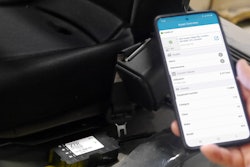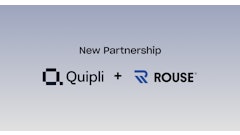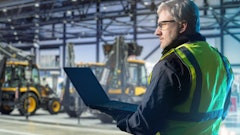
One of the more popular features of rental ERP systems is the ability to track and report on data for the equipment in a rental company’s fleet. In other words, telematics. Often integrated by OEMs into the machine, this data can include everything from location, runtime hours, maintenance statistics, and more.
Think about your fleet—the skid steers, the CTLs, excavators, etc. Think about all the attachments you have for them. Consider the difference between that telematic data for one piece of equipment vs all the attachments that fit and work for that machine. Now think about your latest attachment purchase being lost or stolen. At some point, monitoring all assets becomes part of a larger scope.
 The Locate Pro by GaugeGauge
The Locate Pro by GaugeGauge
LHP designs custom telematics solutions for equipment manufacturers and equipment rental companies. LHP has been working with industry leaders like John Deere for more than a decade and currently supports more than 50 Deere dealers in North America with their telematics needs. In 2021 LHP was one of the first industry specialists to incorporate machine support for Cummin’s Connected Diagnostics. In late 2022, LHP Telematics partnered with InTempo Software, developing InTempo MX —merging LHP’s telematics data with the rental customer contract information to help rental companies visualize equipment location along with its rental and maintenance status for improved operating efficiencies.
Top Tips for Onboarding Telematics: Expert insight into how rental companies can pick and onboard a telematics system.
“A lot of people can supply devices that can track engines. In fact, a lot of excavators and wheel loaders will come with their own,” says Hammar. “But for attachments, it's few and far between that you find anyone [OEMs] that are putting trackers on attachments or has the tracker you can install yourself.”
 Gauge
Gauge
With a motto of “measure what matters”, Gauge provides a comprehensive fleet management solution with maintenance software, the Locate Pro tracking device with built-in GPS, and a mobile app providing rental businesses in-the-field access to location data, machine DTC codes, utilization, and more. Customers with third-party GPS or OEM telematics can import those solutions into the Gauge Smart Hub software and vice versa.
On the software side, linking the ID of a device to the attachment is straightforward. A manager assigns the device to an attachment by a unique identifier like a barcode or serial number. Some systems will even allow rental companies to use their IDs to match their fleet. With an assigned tracker, attachment entries can then be digitally connected to machines—streamlining the process that much further.
"Whether it's an auger or an asphalt planer, I can take the Locate Pro and attach it onto the piece of metal. Nobody knows it's there. It gives me confidence and assurance that I'm going to get that piece back," says Kucharski. "It also tells me where things are at in a somewhat regular basis—that's the big thing about attachments and the rental space."
“One of the misunderstandings out there is that it’s all about maximizing data," says Tony Nicoletti, VP of Sales and Business Development at DPL Telematics. "How much data do we get on my phone plan? How much data am I streaming? There’s a lot of belief that that’s the same for telematics. For some folks that makes sense, but for others it can also be overwhelming,” he says.
He adds: “In today’s world, just knowing where your assets are with the value of rental equipment going up and the prevalence—unfortunately—of theft. There are sophisticated teams targeting equipment and getting very knowledgeable on how to do this. One of the best ways to offset theft is with GPS tracking.”
DPL has been in business for 24 years. Back then, devices were the size of a breadbox and had to sit on the outside of a machine with big antennas and cost upwards of around $1,000. Today they're much more streamlined. The technology has gotten smaller, more powerful, and more affordable. Now, many are small enough to fit in your pocket. The sizes of DPL’s wireless AssetView tracking device line and wired AssetCommand products range to the size of a computer mouse or smaller. They also offer FleetViewOBDII vehicle tracking system and TITAN.
 DPL's TITAN Equipment Monitoring System operates seamlessly on all mobile assets, both on and off-road, for mapping and management of all company trucks and equipment from a single software.DPL Telematics
DPL's TITAN Equipment Monitoring System operates seamlessly on all mobile assets, both on and off-road, for mapping and management of all company trucks and equipment from a single software.DPL Telematics
Location
The risk versus reward is high. Even without fine details, marrying telematics to equipment attachments still provides a handful of benefits. For one, it's helpful in the pickup and delivery process to help ensure they pick up the correct asset. “They have a little bit better knowledge of where it's at on the jobsite—that’s been a huge help,” says Hammar.
“There’s an application for almost everything as far as locations. That’s the first case, where are my assets,” says Nicoletti.
Hammer adds that it helps to have another set of eyes to ensure rented assets (the equipment and attachment) are at the location. “If you knew that bucket went out with that piece of equipment and had a GPS failure on the unit, you still have the bucket to see where that jobsite was,” she says. “It’s good to know if they’re moving them around.” Ecco Acme places a geofence around each jobsite—alerting them if the attachment moves from one job to another.
“Without the visibility of having that GPS unit associated with the attachment,” adds Michael Jakab, CEO of LHP Telematics, “that’s a manual process of somebody walking through yards and taking physical inventories.”
Making that map functional is also vitally important. More than just seeing where assets are, how quickly and easily users can set up a geofence is a major selling point on the interface/software side.
Nicoletti has also seen tracking devices help rental companies manage their fleet of attachments spread out over multiple yards giving them immediacy of where assets are and saving that time of walking around searching.  Inside the AssetView Stealth Tracking System from DPL TelematicsDPL Telematics
Inside the AssetView Stealth Tracking System from DPL TelematicsDPL Telematics
Status
Tracking devices ping data or chirp as often as needed—from every 5 seconds to every couple of months. This schedule is typically set up by the rental house. For Ecco Acme, explains Hammar, they set their devices to update twice a day. “There’s been a couple of cases for us to get updates more frequently, but for the most part it was twice a day,” she says.
“Unlike beacon technology that attempts to rely on Bluetooth and proximity of other cellular based equipment, an asset equipped with a battery powered cellular device can be found just about anywhere, anytime, regardless of other equipment being nearby. The typical use case for tracking attachments has devices waking up between two to four times a day and reporting their position before going back to sleep. That information is reflected in the User Interface (UI) along with customer contract information so dispatchers and customer service team members can answer customer inquiries without putting someone on hold or returning the call at a later time,” says Jakab.
Devices are designed to provide a long run time, many use commercial off-the-shelf batteries. “Even if you’ve got a Bluetooth tag chirping every 5 seconds, one of these is going to last a couple of years,” notes Nicoletti.
“When you’re at the rental counter, your goal is 'get it back, get it available, and get it back on rent,'” adds Hammar. For managers watching assets on the map, ERPs help visualize the status of what's out there and avoid having a driver spend a half-day looking for a bucket two miles away that was dropped two days before.
And, of course, it’s important to ensure that the attachment returned was the specific item on your customer contract. “When you’re dealing with a $40,000 asset that goes out on rent and…suddenly that bucket looks a lot older. You’re just protecting your investment,” says Jakab. “Operating mistakes happen, but leveraging technology to confirm the exact asset is in the correct place can take the emotion out of a contentious customer situation.”
How the tracking device connects as one solution may work better for your operations than another. Common connection options are GNSS radio/satellite, cellular, and long-range Bluetooth. Bluetooth-based tracking devices can either connect to the machine’s telematics system (if it has such technology) or connect to a gateway mounted on the machine.
Soeren Brogaard, the CEO of Trackunit says that they have been building a network for years connecting to tool management technologies like that from Hilti. “We have a network of Bluetooth-enabled devices where we can detect attachment tags across more than 100,000 jobsites.”
Some tracking device manufacturers are developing ways to display more than location data such as advanced information like acceleration or environmental details.
Durability
One of the biggest impediments in attachment telematics has been the abuse various attachments receive. However, today’s hardware has matured enough to withstand the punishment yet small enough that its form factor no longer gets in the way.  LHP Telematics
LHP Telematics
This is a critical component of a rental company's telematic solution. “Attachments get beat,” says Kucharski. However, “the placement and how you attach it is also important. There are two aspects: one is making sure you attach it so it doesn’t fall off. Two, making sure you place it so that it’s not obvious that it has a GPS."
Devices are rated for resistance to water and dust intrusion and vibration. Find a device that's at least rated to IP67, but Nicoletti suggests looking for at least IP68.
LHP continually sources the correct equipment to address a variety of customer requirements. They are currently working with specialty rental companies testing Class One, Div Two devices for tracking equipment in hazardous areas prone to having flammable gasses or vapors present.
Location, Location, Location
There are a few fairly common options for attaching tracking devices to attachments. These include industrial adhesives like epoxies, magnets, welding, or bolting them on. Ecco Acme has opted to weld theirs. They’ve seen people use cages but if something is hitting hard enough to damage the cage (or case) it would likely damage the tracker too. They were also concerned about heat, airflow, and data connection. A casing also increases the footprint of the tracking device and viable space on attachments is already limited.
Hammar’s advice: keep it simple. In fact, she wrote the guide for Ecco Acme on where and how to attach their telematic devices to attachments. It started by asking as many techs as she could about where they would install the device from being demolished quicker than not.
“Keep it away from the business end,” notes Nicoletti, and veer away from the sides where things can get smashed. “Toward the coupling, where it’s a little bit more protected. Usually toward the back is the safest placement.”
LHP recommends installing the device between the ears for buckets and compaction wheels and the backside of the carriage for forks. If necessary, contact the supplier of your device for further instructions on installation.
Wherever you end up deciding to place yours, “Be consistent,” says Kucharski. “I found myself putting two of these on the same machine because I couldn’t figure out where the other one was.” He suggests that rental fleet managers upload a photograph into their system of where the tracker is.
Actionable data will always be helpful but have a plan. “What I recommend is to start with your toe in the shallow end of the pool, because in the deep end you’ll find that you’re going to be swimming in data,” advises Nicoletti. “That’s one of the big misconceptions—that there’s data available and a lot of times you’re not set up to digest it. It creates more work.”




















